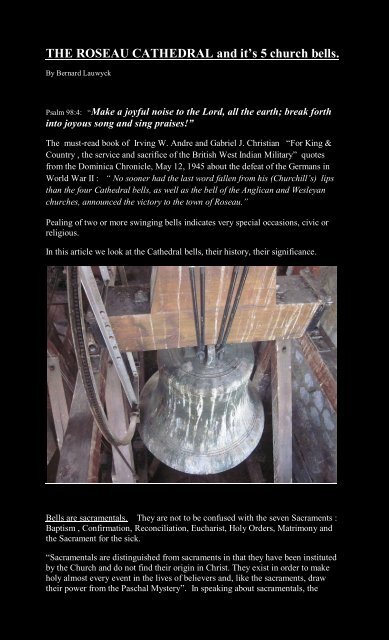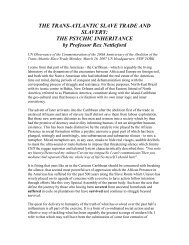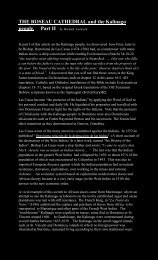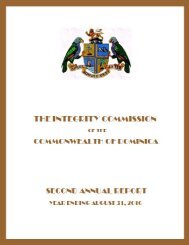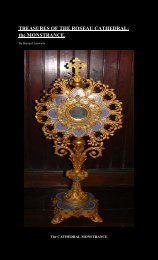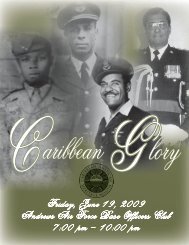Church Bells - Dominica Academy of Arts and Sciences
Church Bells - Dominica Academy of Arts and Sciences
Church Bells - Dominica Academy of Arts and Sciences
- No tags were found...
Create successful ePaper yourself
Turn your PDF publications into a flip-book with our unique Google optimized e-Paper software.
THE ROSEAU CATHEDRAL <strong>and</strong> it’s 5 church bells.By Bernard LauwyckPsalm 98:4: “Make a joyful noise to the Lord, all the earth; break forthinto joyous song <strong>and</strong> sing praises!”The must-read book <strong>of</strong> Irving W. Andre <strong>and</strong> Gabriel J. Christian “For King &Country , the service <strong>and</strong> sacrifice <strong>of</strong> the British West Indian Military” quotesfrom the <strong>Dominica</strong> Chronicle, May 12, 1945 about the defeat <strong>of</strong> the Germans inWorld War II : “ No sooner had the last word fallen from his (<strong>Church</strong>ill’s) lipsthan the four Cathedral bells, as well as the bell <strong>of</strong> the Anglican <strong>and</strong> Wesleyanchurches, announced the victory to the town <strong>of</strong> Roseau.”Pealing <strong>of</strong> two or more swinging bells indicates very special occasions, civic orreligious.In this article we look at the Cathedral bells, their history, their significance.<strong>Bells</strong> are sacramentals. They are not to be confused with the seven Sacraments :Baptism , Confirmation, Reconciliation, Eucharist, Holy Orders, Matrimony <strong>and</strong>the Sacrament for the sick.“Sacramentals are distinguished from sacraments in that they have been institutedby the <strong>Church</strong> <strong>and</strong> do not find their origin in Christ. They exist in order to makeholy almost every event in the lives <strong>of</strong> believers <strong>and</strong>, like the sacraments, drawtheir power from the Paschal Mystery”. In speaking about sacramentals, the
Constitution on the Sacred Liturgy affirms the goodness <strong>of</strong> the material world<strong>and</strong> plainly states that "there is hardly any proper use <strong>of</strong> material things that cannotbe directed toward human sanctification <strong>and</strong> the praise <strong>of</strong> God." These are "sacredsigns instituted by the <strong>Church</strong> that dispose people to receive the chief effects <strong>of</strong> thesacraments <strong>and</strong> they make holy various occasions in human life”.The prinicipal Sacramentals are: The Easter or Paschal C<strong>and</strong>le The Gospel book Holy Oils Incense C<strong>and</strong>les Holy Water Liturgical books <strong>Church</strong> bellsThe largest church bell in the Cathedral, installed in 1985.The use <strong>of</strong> bells for general <strong>and</strong> even for religious purposes is <strong>of</strong> very ancientorigin, although it is likely that in early ages they were <strong>of</strong> very rude form <strong>and</strong>imperfect sound, <strong>and</strong> that they were gradually developed into their presentperfection.The ancient Egyptians used small bells which were rather in the form <strong>of</strong> a flatgong. Moses, who had been educated in the royal <strong>and</strong> priestly class <strong>of</strong> Egypt,introduced them into the ceremonial <strong>of</strong> the Jewish religion as bells to the glory <strong>of</strong>God.
<strong>Bells</strong> are only mentioned 5 times in the Old Testament (see BibleGateway.com).Exodus 28:33-35 describes the vestments worn by the high priest Aaron as heapproached the Ark <strong>of</strong> the Covenant in the Holiest <strong>of</strong> Holies:“All around its lower hem put pomegranates <strong>of</strong> blue, purple, <strong>and</strong> red wool,alternating with gold bells. Aaron is to wear this robe when he serves as priest.When he comes into my presence in the Holy Place or when he leaves it, the sound<strong>of</strong> the bells will be heard, <strong>and</strong> he will not be killed.” This is repeated in Exodus39:25-26: “All around its lower hem they put pomegranates <strong>of</strong> fine linen <strong>and</strong> <strong>of</strong>blue, purple, <strong>and</strong> red wool, alternating with bells <strong>of</strong> pure gold, just as the Lord hadcomm<strong>and</strong>ed Moses.”Again in Sirach 45:9 “Gold bells were also around its hem, so that when hewalked, their ringing would be heard in the Temple, <strong>and</strong> the Lord would rememberhis people. “ Here the bells do not remind the people to worship God but serve toremind the Lord to remember his people.The use <strong>of</strong> bells in synagogues is confirmed by Steven Fine in his book “Art &Judaism in the Greco-Roman world, toward a New Jewish archaeology”: “Thereading <strong>of</strong> Scripture in the “holy tongue”, the sounds <strong>of</strong> bells dangling from richlycoloured textiles in which the “holy writings” were wrapped,..”St. Patrick (c. 389-446) is credited with introducing h<strong>and</strong>bells to Irel<strong>and</strong> around432. He had brought metalworkers with him to fabricate the bells for his newmonasteries, <strong>and</strong> it is thought that he supplied the Irish church with no fewer thanfifty. Relics <strong>of</strong> these early bells can still be seen today in Irish museums.The Irish for a bell is cloc , akin to the Dutch “klok” <strong>and</strong> French “cloche”. TheLatin word is “signa”, which reminds us <strong>of</strong> the word SIGN.The most famous “cloc” is the one <strong>of</strong> St. Patrick, which wasused by him before his death on 17 March, 493 <strong>and</strong> is now inthe National Museum in Dublin: it is the oldest <strong>of</strong> all; <strong>and</strong> itmay be taken as a type <strong>of</strong> the hammered-iron bells. Its heightis 6 1/2 inches. This is the bell known as the 'Bell <strong>of</strong> theWill', so called because it was willed by the saint to one <strong>of</strong>his disciples. It was disinterred from the grave <strong>of</strong> St. Patrickafter having been buried there for sixty years.Tradition tells us that the saint, st<strong>and</strong>ing on the hill <strong>of</strong>Croagh Patrick, used the sound <strong>of</strong> this bell to rid the isl<strong>and</strong> <strong>of</strong>serpents <strong>and</strong> poisonous animals, a metaphor for pagan beliefs<strong>and</strong> practices. St. Patrick, the apostle to the Irish, is the national saint <strong>of</strong> Irel<strong>and</strong>.<strong>Bells</strong> (“signa”) are frequently mentioned in the writings <strong>of</strong> French clerics duringthe sixth century, including an account by St. Gregory, bishop <strong>of</strong> Tours (573-595),referring to their various liturgical uses. Pope Sabinianus ( 604 AD), is said tohave been the first to order bells rung to indicate the canonical hours -the eightperiods <strong>of</strong> prayer <strong>and</strong> devotion- in the monastery. St. Paulinus, the Bishop <strong>of</strong> anItalian town close to Naples, introduced them as a means to summon monks toworship. In the 7th Century the Pope approved the use <strong>of</strong> bells to call the faithfulto the Mass. The Venerable Bede, an English saint <strong>of</strong> the eighth century, iscredited with the introduction <strong>of</strong> bell ringing at Requiem Masses. By the ninth
century the use <strong>of</strong> bells had spread to even the small parish churches <strong>of</strong> the westernRoman Empire. It wasn't until the thirteenth century that outdoor tower bells beganto be rung as "Sanctus bells" during the Mass.So church bells have been a regular feature <strong>of</strong> Christian worship from early on.The bells told people the time <strong>of</strong> day as watches were not available in people’sdaily life. Bell-ringing also announces the times <strong>of</strong> services <strong>and</strong> calls the faithfulto worship. Celebrations , whether personal, civic or national are marked with apeal <strong>of</strong> bells. Pealing <strong>of</strong> two or more swinging bells indicates special celebrations.The sanctus bell is sounded during the Mass, at the Sanctus to signal theconsecration, three times each at the elevation <strong>of</strong> the Host <strong>and</strong> the wine in thechalice. <strong>Bells</strong> are silenced from Holy Thursday until the Gloria at the Easter Vigil,as a commemoration <strong>of</strong> Christ's Passion.The first time we read about the Roseau Cathedral bells in the Diocesan Archivesis when two church bells had to be repaired. “With regard to the bells, two brokenones were sent to a firm in London to be recast; they arrived in November 1873<strong>and</strong> were solemnly consecrated on December 21st, in the presence <strong>of</strong> theGovernor, the Chief Justice <strong>and</strong> a numerous congregation”.The date <strong>of</strong> original installation <strong>of</strong> these two bells is lost in the fog <strong>of</strong> time. How<strong>and</strong> when these bells were broken is another question. One reason could be thatthe hammers or clappers were too heavy for the bells, or that the support structurecollapsed due to lack <strong>of</strong> maintenance or disaster.The date 1873 in the archives, correspondents with the inscriptions found on two<strong>of</strong> the present bells in the cathedral bell tower:Bell # 1 inscription :“ MEARS & STAINBANK FOUNDRY. LONDON 1873 SAINT GEORGES”Bell # 2 inscription :“MEARS & STAINBANK FOUNDRY. LONDON 1873 SAINT JOSEPH “Research about this company on Wikipedia shows <strong>and</strong> I quote:“The company now known as the Whitechapel Bell Foundry dates back to at least1570 but a continuous line <strong>of</strong> master founders in Whitechapel or nearby Aldgateexists since 1420. The present premises on Whitechapel Road date from 1670 ...The company moved there from smaller premises situated on the north side <strong>of</strong> theWhitechapel Road. At an earlier date the foundry was located at Aldgate, London.Traditionally, the foundry has been known by the name <strong>of</strong> the master founder <strong>and</strong>owner, operating from the 19th Century to 1968 as Mears & Stainbank. It hassince operated under the name <strong>of</strong> Whitechapel Bell Foundry.”On the next 2 bells <strong>of</strong> similar size <strong>and</strong> from the same foundry we found theinscription “ SAINT JAMES LONDON 1934”.These were the 4 cathedral bells which announced the Allied victory in 1945 asdescribed in the above-mentioned book.
A fifth bell, a gift from Colmar in the Diocese <strong>of</strong> Strasbourg, France was installedin 1985. This is a bigger bell than the other ones. The inscription has the wordsCOLMAR - DAME DE BON PORT - CATHEDRAL - ROSEAU- 1985-QUAL DICTA SUNTA LONDON - SANCTO MATTHAE-APRES BONDIE C’EST LA TER - DOMINICA + ELISA + CAROLTo explain more about these bells, I need to show you some basic terminology:
The MOUTH or THROAT <strong>of</strong> the 1873 <strong>and</strong> 1934 church bells is 42” ¾ indiameter. Their height is 33”. The WAIST is 26” in diameter. Their weight isabout 400 lbs each.The COLMAR bell, as shown here, dated 1985, is a bigger bell <strong>and</strong> has a MOUTHwith a diameter <strong>of</strong> 49” <strong>and</strong> a height <strong>of</strong> 36”. It’s WAIST is 30” in diameter. It’sweight is about 600 Lbs.These bells were cast in bronze, which is a metal alloy consisting <strong>of</strong> copper with asmall percentage <strong>of</strong> tin. This gives them a deep rich tone.Complete swinging church bells as these have a yoke, clapper, wheel, woodenframe. They used to be rung with old fashion rope pull.The Cathedral had a more sophisticated system : a mechanical clock whichcontrolled the ringing <strong>of</strong> the bells with chains <strong>and</strong> pulleys. Mr. Hubert Josephdevoted his time to keep this system going for a long time <strong>and</strong> he needs to becommended for this.
As mentioned before, the first time we read about the Roseau Cathedral bells in theDiocesan Archives is when two church bells had to be repaired:“With regard to the bells, two broken ones were sent to a firm in London to berecast; they arrived in November 1873 <strong>and</strong> were solemnly consecrated onDecember 21st, in the presence <strong>of</strong> the Governor, the Chief Justice <strong>and</strong> a numerouscongregation”.It has always been the practice <strong>of</strong> the <strong>Church</strong> to bless any object that was used inthe service <strong>of</strong> God <strong>and</strong> so there is a longst<strong>and</strong>ing custom <strong>of</strong> the Latin <strong>Church</strong> tobless church bells or “ solemnly consecrate” as described in the diocesan archives.The consecration <strong>of</strong> a bell is a very solemn function, <strong>and</strong> its origin must be soughtfar back in the eighth century, if not earlier. The role <strong>of</strong> the bells is a very solemn<strong>and</strong> imposing one. The blessing <strong>of</strong> bells has so many features in common with therites <strong>of</strong> Christian initiation that at an early date men spoke <strong>of</strong> the "baptism" <strong>of</strong> abell, rather than <strong>of</strong> its blessing. The oldest known ritual for the blessing <strong>of</strong> a bell is<strong>of</strong> Spanish origin, <strong>and</strong> is found in the “Liber ordinum”, which takes us back to thetime preceding the Arab conquest (713AD) .One <strong>of</strong> the prayers, which accompanies the blessing <strong>of</strong> the water used at the"baptism" <strong>of</strong> a bell reveals a lot about the religious significance <strong>of</strong> church bells:This special Holy Water must be blessed by the bishop, even if he do not himselfbless the bell . The prayer reads:"Bless this water, O Lord, with a blessing from heaven, <strong>and</strong> may the virtue <strong>of</strong> theHoly Spirit come down upon it, that when this vessel, which is prepared forsummoning the children <strong>of</strong> Holy <strong>Church</strong>, hath been moistened with it, whereverthis bell may sound, may the power <strong>of</strong> those who lie in ambush, the shadow <strong>of</strong>apparitions, the attack <strong>of</strong> whirlwinds, the striking <strong>of</strong> lightning, the ruin <strong>of</strong>thunderbolts, the calamity <strong>of</strong> tempests, <strong>and</strong> all spirits <strong>of</strong> storms be scared away;<strong>and</strong> when the children <strong>of</strong> Christians hear its ringing, may devotion grow withinthem, that, hastening to the bosom <strong>of</strong> Holy Mother <strong>Church</strong>, they may there singunto Thee in the assembly <strong>of</strong> the Saints a new canticle, introducing in their musicthe stirring sound <strong>of</strong> the trumpet, the sweet notes <strong>of</strong> the psaltery, the harmony <strong>of</strong>the organ, the cheerfulness <strong>of</strong> the drum <strong>and</strong> the gladness <strong>of</strong> the cymbal: so that bytheir prayers <strong>and</strong> worship they may invite to join them the multitude <strong>of</strong> the Angelichosts who dwell in the holy temple <strong>of</strong> Thy glory."The bell is then washed with the water thus blessed. When the bell has beenwashed, the bishop anoints it on the outside with the oil <strong>of</strong> the sick, after which herecites a prayer in which he once more asks that when "the melody <strong>of</strong> this bellsounds upon the ears <strong>of</strong> the people may their devout faith grow ... May the righth<strong>and</strong> <strong>of</strong> Thy power subdue the powers <strong>of</strong> the air, that, when they hear this bell,they may tremble <strong>and</strong> fly before the st<strong>and</strong>ard <strong>of</strong> the holy cross <strong>of</strong> Thy Son which ismarked upon it... "Once more the bell is anointed, seven times outside with the oil <strong>of</strong> the sick, <strong>and</strong>four times inside with the chrism.<strong>Church</strong> bells are indeed used in time <strong>of</strong> great danger such as a fire, invasion <strong>of</strong>hostile armies , approaching hurricane to warn people <strong>of</strong> a town or village. In myvillage Bellevue Chopin the church bell is tolled for a death <strong>of</strong> anyone regardless<strong>of</strong> creed or religion. A recent tolling was for Dorothy Griffin né Nicholls who was
a member <strong>of</strong> the prominent <strong>Dominica</strong>n family who donated the l<strong>and</strong> for theBellevue chapel <strong>and</strong> dedicated years to the Roseau Cathedral with the upkeep <strong>of</strong>the Cathedral’s <strong>and</strong> Bishop’s yard. We so remember her <strong>and</strong> her family withaffection <strong>and</strong> gratitude.So, pastors <strong>and</strong> Parish Priests, now you know how to increase church attendance:INSTALL AND RING A CHURCH BELL.Bernard Lauwyck .bernardlauw@yahoo.com PO BOX 317 Roseau <strong>Dominica</strong>


